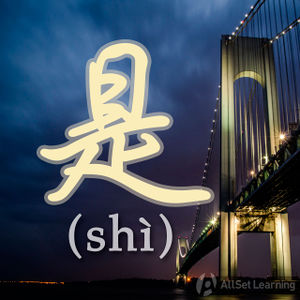Difference between revisions of "Connecting nouns with "shi""
m (Text replace - "{{Grammar Box}} " to "{{Grammar Box}} ") |
m (Text replace - "(\r?\n){2}" to "\r\n") |
||
| Line 1: | Line 1: | ||
| − | {{Grammar Box}} | + | {{Grammar Box}} \r\nThe verb ''to be'' is not used in Chinese the same way as it is in English. In Chinese, 是 (shì) is for connecting [[nouns]], and is generally not used with [[adjectives]]. \r\n== Structure ==\r\nThe structure for connecting nouns with 是 is:\r\n<div class="jiegou">\r\nNoun 1 + 是 + Noun 2\r\n</div>\r\nThis is equivalent to "Noun 1 '''is''' Noun 2" in English.\r\nChinese does not [http://en.wikipedia.org/wiki/Grammatical_conjugation conjugate] verbs. That is, the form of the verb is the same no matter who is doing it. In this case, it is always 是 and never changes. As you can see, it's easy to form simple sentences expressing ''to be'' in Chinese. \r\n== Examples ==\r\n<div class="liju">\r\n* <strong>我</strong> <em>是</em> <strong>学生</strong>。<span class="trans">I am a student.</span> |
| − | |||
| − | |||
| − | |||
| − | == Structure == | ||
| − | |||
| − | |||
| − | |||
| − | <div class="jiegou"> | ||
| − | |||
| − | |||
| − | |||
| − | </div> | ||
| − | |||
| − | |||
| − | |||
| − | |||
| − | |||
| − | == Examples == | ||
| − | |||
| − | <div class="liju"> | ||
| − | |||
| − | * <strong>我</strong> <em>是</em> <strong>学生</strong>。<span class="trans">I am a student.</span> | ||
* <strong>她</strong> <em>是</em> <strong>医生</strong>。<span class="trans">She is a doctor.</span> | * <strong>她</strong> <em>是</em> <strong>医生</strong>。<span class="trans">She is a doctor.</span> | ||
* <strong>他</strong> <em>是</em> <strong>老师</strong>。<span class="trans">He is a teacher.</span> | * <strong>他</strong> <em>是</em> <strong>老师</strong>。<span class="trans">He is a teacher.</span> | ||
| Line 30: | Line 8: | ||
* <strong>那</strong> <em>是</em> <strong>你的礼物</strong>。<span class="trans">This is your gift.</span> | * <strong>那</strong> <em>是</em> <strong>你的礼物</strong>。<span class="trans">This is your gift.</span> | ||
* <strong>这</strong> <em>是</em> <strong>我的衣服</strong>。<span class="trans">That is my clothes.</span> | * <strong>这</strong> <em>是</em> <strong>我的衣服</strong>。<span class="trans">That is my clothes.</span> | ||
| − | * <strong>你</strong> <em>是</em> <strong>我的朋友</strong>。<span class="trans">You are my friend.</span> | + | * <strong>你</strong> <em>是</em> <strong>我的朋友</strong>。<span class="trans">You are my friend.</span>\r\n</div>\r\nBe careful though. As you can see above, 是 is only used to link two nouns. It cannot be used to link a noun and an adjective. This is a very common mistake for people just beginning to learn Chinese. For that kind of sentence, you'll want to use [[Simple "noun + adjective" sentences|the linking word 很]].\r\n==See also==\r\n* [[Word order]] |
| − | + | * [[Simple "noun + adjective" sentences]]\r\n== Sources and further reading ==\r\n* [[Integrated Chinese: Level 1, Part 1 (3rd ed)]] (pp. 29) [http://www.amazon.com/gp/product/0887276385/ref=as_li_ss_tl?ie=UTF8&tag=allset-20&linkCode=as2&camp=217145&creative=399369&creativeASIN=0887276385 →buy] | |
| − | </div> | ||
| − | |||
| − | |||
| − | |||
| − | ==See also== | ||
| − | |||
| − | * [[Word order]] | ||
| − | * [[Simple "noun + adjective" sentences]] | ||
| − | |||
| − | == Sources and further reading == | ||
| − | |||
| − | * [[Integrated Chinese: Level 1, Part 1 (3rd ed)]] (pp. 29) [http://www.amazon.com/gp/product/0887276385/ref=as_li_ss_tl?ie=UTF8&tag=allset-20&linkCode=as2&camp=217145&creative=399369&creativeASIN=0887276385 →buy] | ||
* [[Chinese: An Essential Grammar, Second Edition]] (pp. 47-8) [http://www.amazon.com/gp/product/0415372615/ref=as_li_ss_tl?ie=UTF8&tag=allset-20&linkCode=as2&camp=217145&creative=399369&creativeASIN=0415372615 →buy] | * [[Chinese: An Essential Grammar, Second Edition]] (pp. 47-8) [http://www.amazon.com/gp/product/0415372615/ref=as_li_ss_tl?ie=UTF8&tag=allset-20&linkCode=as2&camp=217145&creative=399369&creativeASIN=0415372615 →buy] | ||
* [[New Practical Chinese Reader 1 (新实用汉语课本1)]] (pp. 44) [http://www.amazon.com/gp/product/7561910401/ref=as_li_ss_tl?ie=UTF8&tag=allset-20&linkCode=as2&camp=217145&creative=399369&creativeASIN=7561910401 →buy] | * [[New Practical Chinese Reader 1 (新实用汉语课本1)]] (pp. 44) [http://www.amazon.com/gp/product/7561910401/ref=as_li_ss_tl?ie=UTF8&tag=allset-20&linkCode=as2&camp=217145&creative=399369&creativeASIN=7561910401 →buy] | ||
* [[New Practical Chinese Reader 1 (新实用汉语课本1)(2nd ed)]] (pp. 50-1) [http://www.amazon.com/gp/product/7561926235/ref%3das_li_ss_tl?ie=UTF8&tag=allset-20&linkCode=as2&camp=217145&creative=399373&creativeASIN=7561926235 →buy] | * [[New Practical Chinese Reader 1 (新实用汉语课本1)(2nd ed)]] (pp. 50-1) [http://www.amazon.com/gp/product/7561926235/ref%3das_li_ss_tl?ie=UTF8&tag=allset-20&linkCode=as2&camp=217145&creative=399373&creativeASIN=7561926235 →buy] | ||
| − | *[[40 Lessons for Basic Chinese Course (基础汉语40课上册)]] (p. 62)[http://www.amazon.com/gp/product/B001FTL8D8/ref=as_li_ss_tl?ie=UTF8&camp=1789&creative=390957&creativeASIN=B001FTL8D8&linkCode=as2&tag=allset-20 →buy] | + | *[[40 Lessons for Basic Chinese Course (基础汉语40课上册)]] (p. 62)[http://www.amazon.com/gp/product/B001FTL8D8/ref=as_li_ss_tl?ie=UTF8&camp=1789&creative=390957&creativeASIN=B001FTL8D8&linkCode=as2&tag=allset-20 →buy] \r\n[[Category:A1 grammar points]] |
| − | |||
| − | [[Category:A1 grammar points]] | ||
{{Basic Grammar|是|A1|A + 是 + B|我 <em>是</em> 学生 。|grammar point|ASGUN7RX}} | {{Basic Grammar|是|A1|A + 是 + B|我 <em>是</em> 学生 。|grammar point|ASGUN7RX}} | ||
{{Similar|Word order}} | {{Similar|Word order}} | ||
Revision as of 06:14, 26 November 2013
-
Level
-
Similar to
-
Used for
-
Keywords
\r\nThe verb to be is not used in Chinese the same way as it is in English. In Chinese, 是 (shì) is for connecting nouns, and is generally not used with adjectives. \r\n== Structure ==\r\nThe structure for connecting nouns with 是 is:\r\n
\r\nThis is equivalent to "Noun 1 is Noun 2" in English.\r\nChinese does not conjugate verbs. That is, the form of the verb is the same no matter who is doing it. In this case, it is always 是 and never changes. As you can see, it's easy to form simple sentences expressing to be in Chinese. \r\n== Examples ==\r\n
- 她 是 医生。She is a doctor.
- 他 是 老师。He is a teacher.
- 这 是 书。This is a book.
- 那 是 杯子。That is a cup.
- 她 是 我 的 老板。She is my boss.
- 这 些 是 红玫瑰。
- 那 是 你的礼物。This is your gift.
- 这 是 我的衣服。That is my clothes.
- 你 是 我的朋友。You are my friend.\r\n
\r\nBe careful though. As you can see above, 是 is only used to link two nouns. It cannot be used to link a noun and an adjective. This is a very common mistake for people just beginning to learn Chinese. For that kind of sentence, you'll want to use the linking word 很.\r\n==See also==\r\n* Word order



